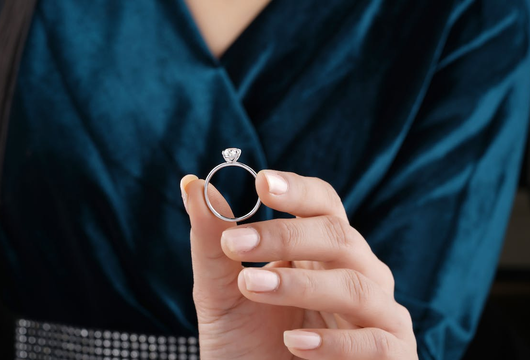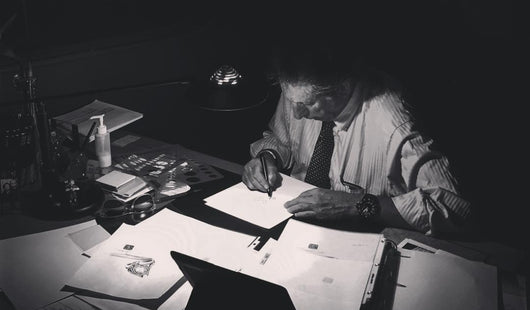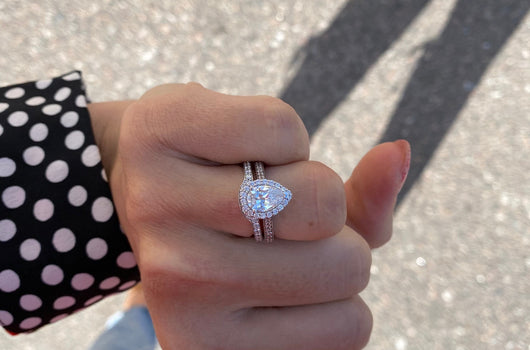Moissanite vs. Lab Diamonds - Which Is Considered Fake?

Very few things compare to the breathtaking brilliance of a natural diamond. For people in search of less expensive alternatives, however, lab grown diamonds and moissanite gemstones are common choices. But which option is considered a “fake” diamond? Let’s explore the benefits, drawbacks and misconceptions associated with these natural diamond alternatives.
Defining Moissanite and Lab Diamonds
Just a few decades ago, it would have seemed virtually impossible to create man-made diamonds with the same stunning appearance and exquisite physical properties as natural diamond gemstones. Now, innovative technology has turned this vision into a stunning reality.
Made in dedicated facilities, lab diamonds are created using responsibly sourced raw materials. By analyzing the Earth’s natural processes, modern technicians are able to effectively recreate the intense heat and high-pressure environment in which natural diamonds form deep within the ground. By doing so, they can artificially create diamonds that are chemically and physically identical to natural diamonds in every way.
Master artists such as John Atencio can then incorporate these lab-grown gemstones into their designs, creating striking lab diamond jewelry that is essentially identical to jewelry made with natural diamond stones.
Like lab created diamonds, moissanite is typically made in a laboratory setting. That said, unlike lab diamonds, moissanite can also be found in the natural world. Whatever their origin, these gorgeous gems have become trendy diamond alternatives due to their shimmering aesthetic and lower price tag.
One of the rarest minerals found on Earth, moissanite was originally discovered in the late 19th century deep within a meteor crater in the state of Arizona. Although it is quite rare, modern scientists are able to use complex technology to create these gems in a laboratory setting. The result is a cheaper diamond alternative with striking fire and warm peachy hues.
Comparable to diamonds in brilliance and durability, moissanite gemstones are especially popular for their affordable pricing, which is typically only a fraction of the cost of a natural diamond. Similar to natural diamonds in color, these lab-made gemstones put an unconventional twist on the classic diamond engagement ring. But despite their perceived benefits, natural moissanite gemstones are not real diamonds and this is one of the reasons most budget-conscious shoppers prefer lab-grown diamond gemstones.
The Stigma of "Fake" Gems
Unfortunately, lab diamonds have been mischaracterized as “fake” diamonds when they’re really natural diamond alternatives. As previously mentioned, lab diamonds are physically, chemically and optically identical to natural diamonds. The only discernible difference is that lab diamonds include microscopic inscriptions identifying them as such.
On the other hand, since moissanite is often showcased in an attempt to “pose” as a diamond, it is often considered to be a “fake” diamond from the perspective of many.
When people talk about “fake” diamonds, they’re usually referring to cubic zirconia. This is a diamond simulant made by melting zirconium oxide powder with stabilizers like calcium and magnesium at nearly 5,000º F. As the melted slurry cools, crystals ultimately form, creating a product that can be cut and polished to mimic certain diamond shapes, such as oval and cushion-cut diamonds.
Sometimes, people will also use other colorless natural gemstones to simulate diamonds. Natural materials, such as colorless topaz, quartz, beryl, sapphire and zircon, have been used as diamond simulants for centuries.
Moissanite is often used in the same way in an attempt to simulate the look of an actual diamond at a much cheaper price tag.
On the other hand, it’s important to know that lab diamonds are real diamonds. They’re just sourced differently than diamonds made naturally within the Earth. While they may cost less than natural diamonds, it’s not possible to tell them apart with the untrained eye and without specialized equipment that can read the microscopic inscriptions.

Can You Really Tell the Difference Between Moissanite And Lab Grown Diamonds?
While they don’t have the same properties as diamonds, moissanite gemstones have a comparable look at a lower price. But while moissanite is a fashionable gemstone that can be used to resemble a diamond, it’s not even close to a diamond in appearance or composition.
Since it has different types of faceting patterns, moissanite’s brilliance isn’t the same as that of a natural or lab-grown diamond. While moissanite does have a higher refractive index (2.65-2.69, as opposed to 2.45 for diamonds), diamond gemstones reflect light in a more complex manner via brilliance, scintillation and dispersion. This is why both natural and lab diamond gemstones boast their unrivaled sparkle.
While lab diamonds can be colorless or colored, moissanite will usually have warmer tones. In most instances, this coloring will be more obvious in bigger moissanite stones. While lab-grown diamonds are graded based on the 4Cs of diamonds (cut, clarity, color, carat), moissanite is usually only graded on color because the cut and clarity are similar across varying qualities of moissanite gemstones.
On the Mohs hardness scale for gemstones, moissanite scores a 9.25, while lab diamonds boast a perfect 10. While 9.25 is a relatively high score, scratches can cause moissanite gems to lose some of their sparkle, while lab diamonds have the exact same durability as natural diamonds found deep within the Earth.
While lab diamonds are more affordable than natural diamonds, their cost can range based on shape, carat, cut, color and clarity. Moissanite is priced lower than both lab and natural diamonds, with costs varying based on stone size and whether the gem is rated as Premium or Super Premium. While each option is budget-friendly, it’s important to remember that lab diamonds are essentially the same both physically and optically as natural diamonds. Moissanite, on the other hand, is a completely different material with its own unique chemical composition.
The John Atencio Difference
If you've been searching for an affordable, eco-friendly natural diamond alternative, John Atencio’s lab diamond engagement rings are an inspired choice. And when one of our beautiful lab-grown gems is paired with an exquisite John Atencio setting, you get a breathtaking artistic expression of luxury unlike anything else.
Make an appointment at one of our locations, where our experienced, attentive team will provide a personalized approach to help you find a stunning jewelry piece for your unique style or the exact right custom engagement ring for that monumental moment.


